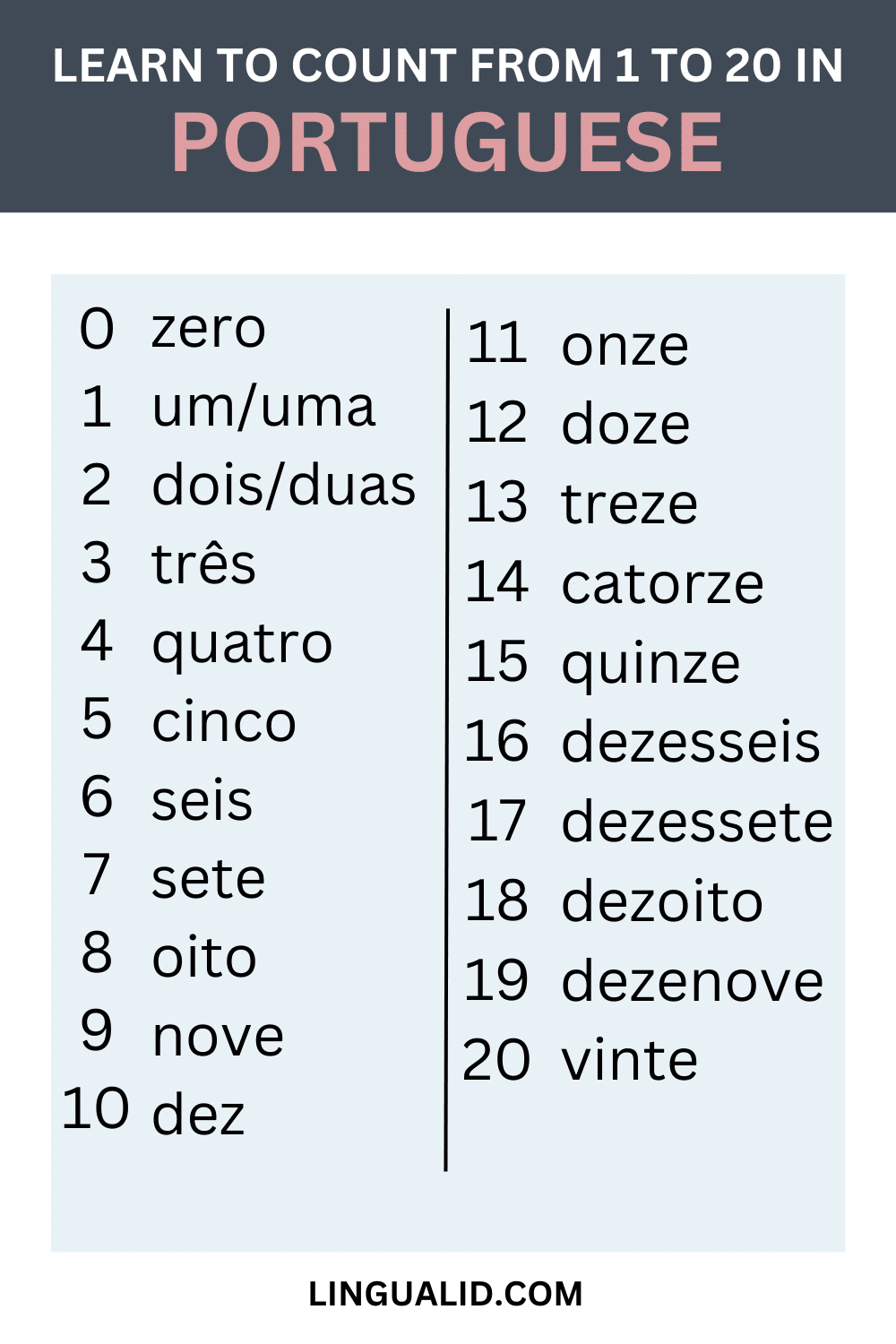Learning how to count in Brazilian Portuguese is a basic yet very important skill to any Portuguese language learner, using it you can tell the hour, and your age, understand the cost of something or even tell how long you’re staying in a certain place.
So in this post, you will learn how to count from 0 to 20 in Portuguese (with audio) and then learn how to say numbers until 1 Billion! yes, you read it right.

Counting From 0 To 20 In Brazilian Portuguese
| Number | Portuguese |
| 0 | zero |
| 1 | um/uma |
| 2 | dois/duas |
| 3 | três |
| 4 | quatro |
| 5 | cinco |
| 6 | seis |
| 7 | sete |
| 8 | oito |
| 9 | nove |
| 10 | dez |
| 11 | onze |
| 12 | doze |
| 13 | treze |
| 14 | catorze |
| 15 | quinze |
| 16 | dezesseis |
| 17 | dezessete |
| 18 | dezoito |
| 19 | dezenove |
| 20 | vinte |
Note: you can practice what you’ve learned here, and learn how to pronounce each of the words in our Memrise course here, don’t know how to use the platform or sign up? we’ve got you covered in this easy-to-follow tutorial here.

As you notice “one” and “two” have two versions that agree with the genders of the things that are counted, e.g:
One boy – um menino
One girl – uma menina
Two boys – dois meninos
Two girls – duas meninas
Um/uma can also mean “a”, for example a boy / um menino
Multiples Of 10
| Number | Portuguese |
| 10 | dez |
| 20 | vinte |
| 30 | trinta |
| 40 | quarenta |
| 50 | cinquenta |
| 60 | sessenta |
| 70 | setenta |
| 80 | oitenta |
| 90 | noventa |
“Cem” vs “Cento”
We use “cem” to say “one hundred” of something (EXACTLY ONE HUNDRED) if you’d like to say 100 followed by any other number, you would instead use “cento“:
100 – cem
101 – cento e um/uma
102 – cento e dois/duas
154 – cento e cinquenta e quatro
Hundreds And Beyond
| Number | Portuguese |
| 100 | cem |
| 200 | duzentos/duzentas |
| 300 | trezentos/trezentas |
| 400 | quatrocentos/quatrocentas |
| 500 | quinhentos/quinhentas |
| 600 | seiscentos/seiscentas |
| 700 | setecentos/setecentas |
| 800 | oitocentos/oitocentas |
| 900 | novecentos/novecentas |
Notice that these numbers have masculine and feminine forms, which means that they must agree with the noun’s gender (being counted).
Counting From 1000 To 9000
In the following list, you will notice that “mil” (one thousand) doesn’t change in the plural form (e.g. 2000 dois mil), while “milhão” does change (e.g. 2000000 dois milhões)
| Number | Portuguese |
| 1000 | um mil |
| 2000 | dois mil |
| 3000 | três mil |
| 4000 | quatro mil |
| 5000 | cinco mil |
| 6000 | seis mil |
| 7000 | sete mil |
| 8000 | oito mil |
| 9000 | nove mil |
Let’s see some big numbers:
| Number | Portuguese |
| 10.000 | dez mil |
| 20.000 | vinte mil |
| 30.000 | trinta mil |
| 40.000 | quarenta mil |
| 100.000 | cem mil |
| 200.000 | duzentos mil |
| 500.000 | quinhentos mil |
| 1.000.000 | um milhão |
| 2.000.000 | dois milhões |
| 1.000.000.000 | bilião |
| 5682 | cinco mil oitenta e dois |
| 2022 | dois mil vinte dois |
| 2006 | dois mil e seis |
| 6400 | seis mil e quatrocentos |
That was our lesson on how to count in Brazilian Portuguese, try to practice as much as possible to get used to it.
Brazilian Portuguese Numbers: A Study Guide
Quiz
- What is the difference between “cem” and “cento”?
- Provide the masculine and feminine forms of the number 700 in Portuguese.
- How do you say “one girl” and “two girls” in Portuguese?
- Translate the following into Portuguese: 2,568.
- Explain the gender agreement for numbers larger than 100 in Portuguese.
- What is notable about the plural form of “mil” (thousand) when forming larger numbers?
- How do you say “one million” and “two million” in Portuguese?
- Translate the year 2023 into Portuguese.
- Provide the Portuguese words for 40, 50, and 60.
Answer Key
- “Cem” means “one hundred” exactly, while “cento” is used before other numbers to form hundreds larger than one hundred (e.g., 101).
- Masculine: setecentos; Feminine: setecentas
- One girl: Uma menina; Two girls: Duas meninas
- Dois mil quinhentos e sessenta e oito
- Numbers like “duzentos” (200) have both masculine and feminine forms to agree with the noun they modify (e.g., “duzentos livros” – two hundred books).
- “Mil” remains in its singular form even when expressing quantities larger than one thousand (e.g., “dois mil” – two thousand).
- One million: Um milhão; Two million: Dois milhões
- Dois mil e vinte e três
- 40: Quarenta; 50: Cinquenta; 60: Sessenta
Happy learning!
Oualid Cheddadi is the founder of Lingualid, a platform that inspires independent language learners worldwide, regardless of the language they are learning. The name “Lingualid” is derived from the Portuguese word for “language,” “língua,” and the last three letters of Oualid’s name, “Lid.”



